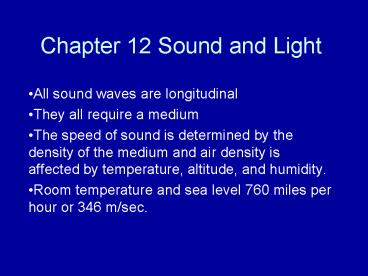Chapter 12 Sound and Light PowerPoint PPT Presentation
Title: Chapter 12 Sound and Light
1
Chapter 12 Sound and Light
- All sound waves are longitudinal
- They all require a medium
- The speed of sound is determined by the density
of the medium and air density is affected by
temperature, altitude, and humidity. - Room temperature and sea level 760 miles per hour
or 346 m/sec.
2
Speed of sound in various mediums
- Air (0 C) 331 m/s
- Air (25 C) 346 m/s
- Air (100 C) 386 m/s
- Water 1490 m/s
- Sea water 1530 m/s
- Copper solid 3813 m/s
- Iron 5000 m/s
- Solid rubber 54 m/s
3
Speed of sound in a medium
- Some materials transfer the energy more easily
than other materials. - Sound travels through solids faster than liquids
and through liquids faster than gases! - If the solid inhibits the sound transfer it can
be used for sound proofing rubber, cork, fiber
tiles.
4
Loudness
- Loudness is determined by energy,
- Energy is determined by amplitude
- Distance also affects loudness!
- Intensity describes the loudness of a sound from
a particular distance from the source. - A sound with twice the intensity doesnt sound
twice as loud, it sounds 10X louder.
5
Relative Intensity Scale
- Determined by comparing the intensity of a sound
with the quietest sound a person can hear
(threshold of hearing). - The decibel (dB) unit is a relative scale.
- The quietest sounds humans can hear is 0
decibels, a 10 dB sound is twice as loud. - A sound of 120 dB is at the threshold of pain.
- Louder than 120 dB sustained result in permanent
deafness and headaches.
6
Pitch
- The frequency of sound determines the pitch the
higher the frequency the higher the pitch the
shorter the wavelength, the shorter the period. - High pitches are created by something vibrating
rapidly these are generally produced by smaller
instruments. - Trained musicians can hear as little a difference
as 2 Hz
7
Hearing Thresholds
- The limit of human hearing 20 Hz to 20,000 Hz.
- Infrasound sound range below the human
threshold. (lower than 20 Hz) - Elephant 6Hz to 12 000 Hz
- Ultrasound sound range above the human
threshold. (above 20 000Hz) - Dog 40 Hz to 40 000 Hz,
- Cat to 45 Hz 64 000 Hz
- Dolphin 70 Hz to 150 000 Hz
- Bat 2000 Hz to 110 000 Hz
- Mouse 1 000 Hz to 91 000 Hz
- Goldfish 20 Hz to 3 000 Hz
8
Music Instruments
- All musical instruments use standing waves to
produce sound. - A standing wave involves a primary wave and a
reflected wave which interfere with one another. - In a standing wave, the two ends of the string
become nodes and the string vibrates in between
them.
9
Standing Waves
- This site shows how standing waves are created.
- http//id.mind.net/zona/mstm/physics/waves/standi
ngWaves/standingWaveDiagrams1/StandingWaveDiagrams
1.html
10
Standing waves demonstrated in a Lab
- This site shows standing waves of various
harmonics. - http//www.pkwy.k12.mo.us/west/teachers/sci_videos
/StandingWaves.mov
11
Tacoma Narrows
- November 7, 1940 near Tacoma Washington, across
the Puget Sound stood an engineering marvel,
until a few months after its completion - the
wind found its natural frequency and created a
standing wavethat lead to complete collapse. - http//www.civeng.carleton.ca/Exhibits/Tacoma_Narr
ows/
12
Musical instruments
- The primary standing wave on a string instrument
has a wavelength twice the length of the string.
This is the fundamental frequency. - In a flute, the standing wave occurs in the
column of air inside the flute. - The wavelength and frequency of the standing wave
is changed by opening and closing holes that
change the length of the air column. - On percussion, standing waves form on the drum
head.
13
Standing waves on a speaker
- The rice collects in the nodes and moves away
from the vibrating part of the speaker called the
antinodes. Changing the frequency changes the
locations of the nodes. The node areas of the
speaker take on various geometric patterns. - http//www.youtube.com/watch?vnO0bSSXmr1A
14
Harmonics
- A tuning fork produces a pure tone of only one
pitch or frequency. - A clarinet produces sounds at several pitches
because its air column vibrates at its
fundamental frequency and a some whole number
multiples of that frequency or harmonics. This
produces a complex wave with its own unique
resulting from the intensity of different
harmonics in each note from the clarinet. - Every instrument has its characteristic sound
quality from its own mixture of harmonics.
15
Harmonics
16
Resonance
- Instruments use resonance to amplify sound.
- The vibration of one object causes the vibration
of another object. - The body of the guitar will vibrate at its
specific natural frequencies. - The vibrating string causes the body of the
guitar to vibrate at a natural frequency. When
the string and guitar body vibrate at the same
frequency, this is resonance, and when it occurs
the sound is amplified.
17
Sonar
Ultra Sound is transmitted until it strikes
another surface and reflects back To the source.
The amount of time between when it was
transmitted and Received back allows locating
objects distance and direction from the source.
distant
18
Ultrasound Imaging
- With high speed digital computing we are able to
observe developing fetuses. This one is 23 weeks. - Ultrasound has wavelength of less than 1 nm and a
frequency of 15 M Hz.

